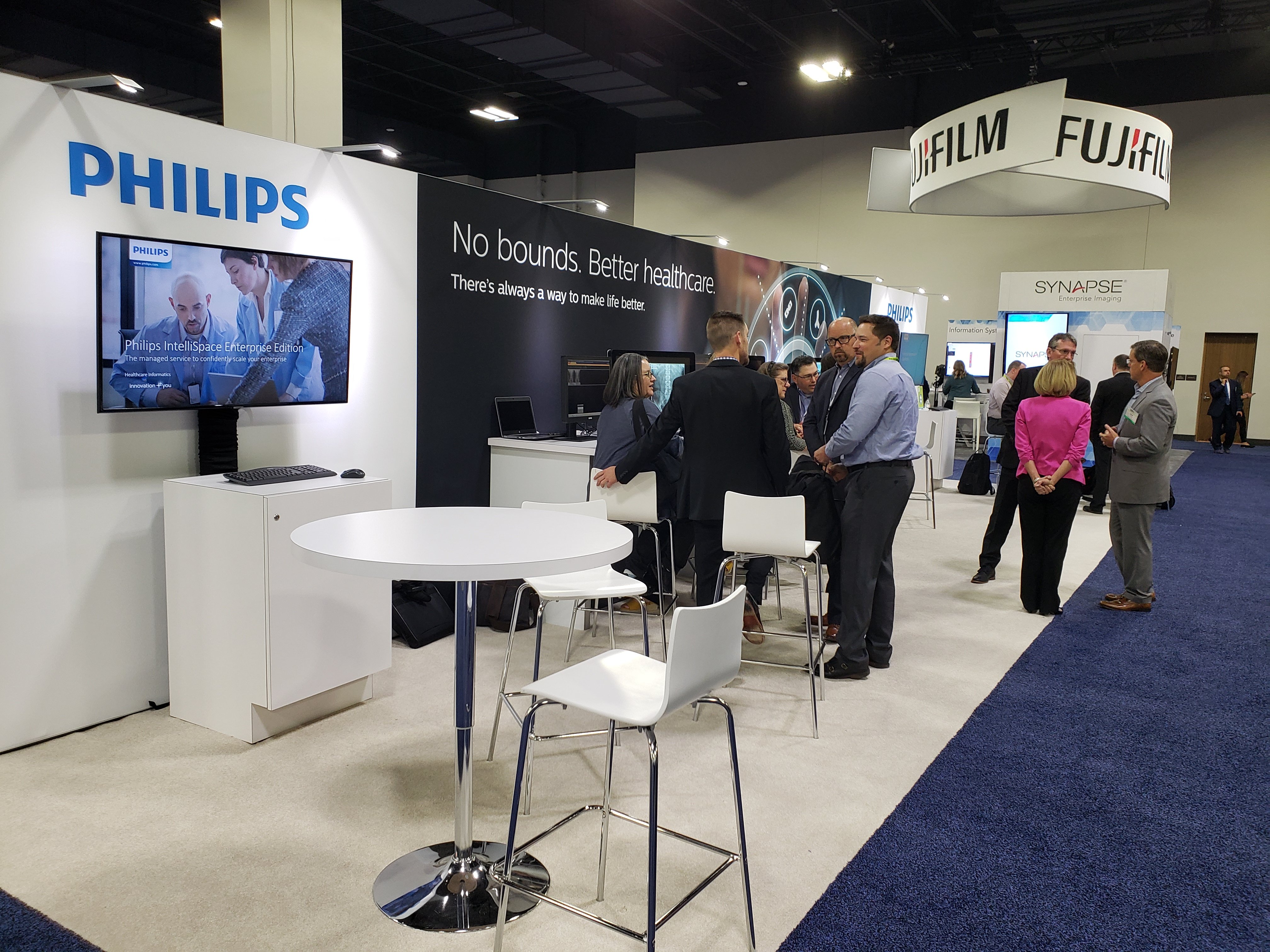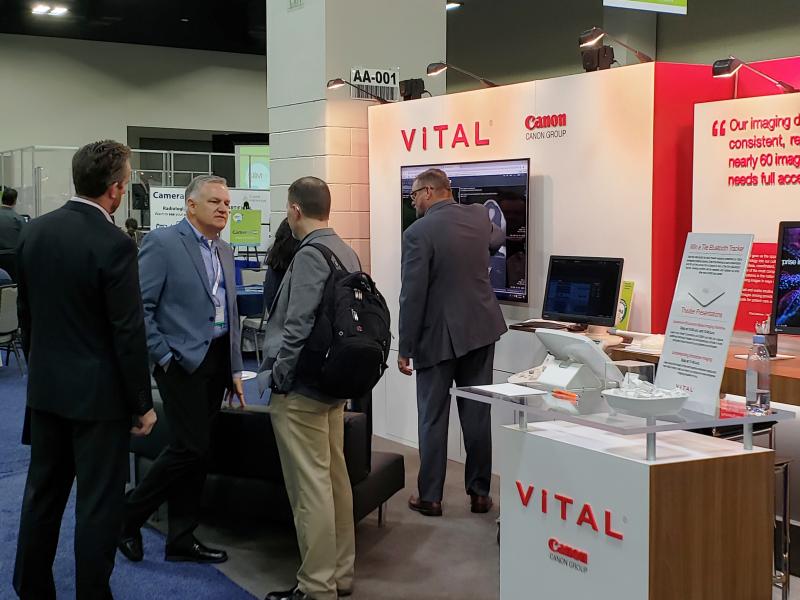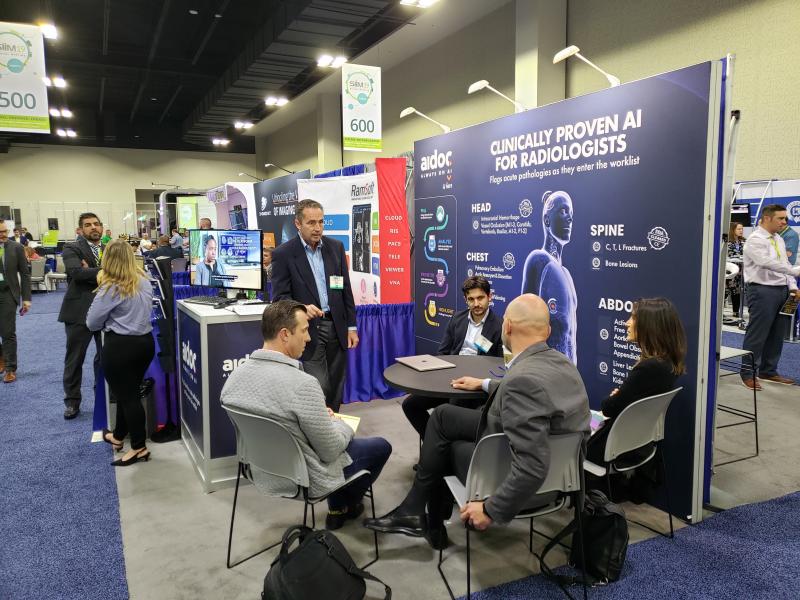
Philips and Fujifilm booths at SIIM 2019.
Pragmatism from cybersecurity to enterprise imaging was in vogue at the 2019 meeting of the Society of Imaging Informatics in Medicine (SIIM). Not unexpectedly, artificial intelligence accounted for much discussion amid telltale cracks in its hype.
Exerting pressure was an undercurrent of practicality, bubbling up in session talks by key opinion leaders (KOLs) and from the exhibit floor, where some company representatives spoke of the continuing need for artificial intelligence (AI) to demonstrate an ROI (return on investment).
This doff of the hat to practicality could be seen in the format of scientific sessions, which were kicked off by luminary speakers providing the context in which to understand research data presented in follow-on talks. Among the takeaways were that:
• Natural language processing (NLP) can extract information from the free text of radiology reports;
• Smart algorithms might provide a safety net for patients and providers by keeping track of important follow-up recommendations in radiology reports;
• Simple neural networks can be better than a complex one; and
• Smart software can improve the performance of resident radiologists to the expert level. (Some evidence shows that, even on its own, the software can outperform non-expert radiologists.)
Other sessions featured faculty, as in the case of one about cybersecurity hosted by J. Anthony Seibert, Ph.D., an imaging physicist on the radiology faculty of the University of California in Davis.
Raising Awarness of Radiology IT Cybersecurity Issues
Just being aware of the security threat posed by hackers is an important first step forward, Seibert said. Easy to do and low-cost follow-on steps can go a long way toward keeping hackers away, he said. These include backing up disks, encrypting laptops and patching known shortcomings in software.
Security was on the mind of Woojin Kim, M.D., chief medical imaging information officer for Nuance Communications, when he spoke about the significance of blockchain in medical imaging. Formerly a practicing radiologist at the University of Pennsylvania Health System, Kim sought to “demystify” blockchain technology, describing what it is and how it is relevant to medical imaging. Increased security, a result of blockchain’s inherent design, was one of its advantages, he said.
Enterprise Imaging Architect Matthew Hayes, MBA, CIIP, spoke on ways to fix a floundering enterprise imaging network. Hayes described how to clean up problem areas in the session titled “Tidying Up.”
AI Attracts Attention
Surprising no one, SIIM 2019’s buzz acronym was AI. But speakers, including Charles E. Kahn, Jr., M.D., FACR, professor of radiology at the Hospital of the University of Pennsylvania and vice chair of the department of radiology at the University of Pennsylvania, and company reps on the exhibit floor offered it up with pragmatic aplomb. At the Dwyer Lecture, Kahn described how to make AI safe, effective — and humane. (To be humane, AI must show that it can improve “the care of our patients” while preserving the “dignity, beneficence and autonomy” of physicians, according to Kahn.)
KOLs and company reps lauded AI for its potential, but said smart algorithms have to prove their value. A luminary presenter at one session, Stephen B. Hobbs, M.D., medical director of imaging informatics at the University of Kentucky, said there are some excellent use cases for AI — but “we will find some cases where (AI) does not really work the way we need it to — at least not until a long time down the road.”
Greg’s Journal at SIIM
Day One: Tuesday
9:45 pm (SIIM time, aka Mountain Daylight) — Land at Denver Airport. The wait for a hotel shuttle takes a lot longer than the ride to the hotel 7 miles away.
10:15pm — Check into Fairfield Inn (close to SIIM 2019).
Day Two: Wednesday
9:02 am — Take Lyft to conference. New construction punctuates light traffic — traveling miles in just minutes; love the commute.
9:30 am — Pick up badge; take a hike — a long one — to exhibit floor. Browse booths; speak with sales reps.
10:07 am — GE is decidedly old school from its messaging (“Elevating Radiology”) to its (mostly) blue-colored booth. Collaboration plays a prominent role. Centricity Solution for Enterprise Imaging is grounded in data management and sharing. The objective? Increased efficiency. Depending on the radiologist this can translate into more time for academic pursuits, diagnosing tougher cases or participating on the patient care team.
10:32am — IBM’s booth runs the gamut from Watson Health to interoperability to functionalities that ingest, manage, store, view, share and exchange medical images. All are mixed in with history going back to Merge Healthcare (the formerly standalone PACS and services vendor acquired in 2015 by IBM).
10:43 am — Multimodality display screens dominate Eizo’s SIIM booth.
11:01 am — Ambra’s message: stop using CDs to transfer patient images; next-generation image management tools make more sense. Cloud-based technologies are better suited to the future management, uploading, and sharing of images.
11:17 am — Barco launches a remote reading solution built around its eGFX graphics box, which securely drives medical-grade displays. Supporting the launch are the growth of teleradiology and the need of prospective employers to meet the expectations of young radiologists to strike a 21st Century life-work balance. The technology is designed to give radiology employers an advantage by providing a secure and uniform work environment regardless of location — be it in a hospital, clinic or home. (Automated QA and calibration remove the challenges of managing medical workstations across multiple locations, according to the company.)
11:30 am — Konica Minolta Healthcare frames its Exa platform as providing secure access across the enterprise. But the technology can be more narrowly focused as a radiology PACS or RIS (radiology information system); for a single purpose, for example, to support radiology billing; or for image archival and retrieval in mammography, orthopedics or cardiology.
1:15 pm — Luminary speaker Curtis Langlotz, a professor of radiology at Stanford University where he researches machine learning technologies, opens a session on natural language processing (NLP). Waxing nostalgic about how language has evolved, Langlotz describes how words contained in radiology reports today might serve as “vectors” that AI can use to process text. SIIM presenters later in the session describe how NLP might be built into smart algorithms. In the role of spotting incidental findings that need follow-up, these algorithms could serve as safety nets to catch radiologist recommendations that might otherwise fall through cracks.
Day Three: Thursday
8:01 am — University of Kentucky Medical Informatics Director Hobbs starts a session on machine learning in chest imaging. Afterward, he says metaphorically, “some fruit can be picked with relative ease,” for example, pneumonia, lung nodules and cancers. Whereas others, such as interstitial lung disease, COPD and diffuse pulmonary disease, are “considerably more challenging.” Artificial intelligence is in its infancy, but it will gain traction over time, he predicts.
11:02 am — Aidoc’s smart software can be “always on,” and “comprehensive,” according to a rep at the company’s SIIM booth. Integrated into clinical workflows through Aidoc’s “AI orchestrator,” FDA-cleared algorithms can evaluate imaging results for intracranial hemorrhage, fractures of the spinal vertebrae, and pulmonary embolism. The software might then notify radiologists of anomalies. Aidoc algorithms have “critical impact as opposed to being scientific only,” a company rep tells me.
11:30 am — Carestream and Philips are just an aisle apart on the exhibit floor. But the juxtaposition is coincidental despite the two being in the midst of a planned merger. Neither could say much about the pending deal (gag rules are in effect) except the reasons behind the merger, reasons that have already been well publicized (e.g., the complementary nature of product lines; the compatibility of corporate cultures, etc). But the two companies address points not directly involved in the prospective merger: Carestream insists its X-ray modality is going strong; Philips argues against “best of breed” solutions. Philips’ long-standing contention is that, although best of breed components can be optimized for specific solutions, they do not necessarily deliver optimal results as a system. Doing so hinges on enablement — does the whole system satisfy clinical needs? Or do interoperability issues get in the way? Will Carestream’s Vue products be integrated with Philips’ IntelliSpace? (We’ll have to wait to find out.)
12:12 pm — Siemens promotes the operational aspects of its hardware. Digitalization is the common thread; analytics the critical fiber. Artificial intelligence is part of the solution, a company rep tells me — but only a part. Making that point is cloud-based TeamPlay, which the company describes as a network for imaging departments. TeamPlay -- which does not involve AI — takes center stage at the Siemens booth for its critical role in evaluating the use of imaging devices. (Through this network, imaging departments can assess scanner utilization, workflow performance, and patient exams, according to the company, the data available to compare to those of other imaging departments so as to help make clinical, financial or operational decisions.) The point is to ensure an ROI that can be measured instead of hoped for, a Siemens rep tells me. Doing otherwise risks overpromising; the development of expectations that can’t be realized; and disappointment.
12:46 pm — TeraRecon features “a workflow enhancement” that strips off patient health information (PHI) before clinical data are sent through the cloud for interpretation by smart algorithms. Interpretations can then be sent back to the clinical sites, a rep tells me. This allows the clinical sites to control PHI, while still allowing AI interpretation through the cloud.
12:53 pm — Vital Images (which has joined Canon Medical) features an optical camera designed specifically for enterprise imaging. The camera downloads patient data either from the patient wristband or a computer work list, associating those data with the appropriate patient record and treatment information. It also measures automatically the distance from camera to subject — for example, a pressure ulcer of the skin — adjusting the image to ensure an “apples to apples” comparison of prior and current images. This helps the physician determine if the wound is getting larger or smaller over time, a rep told me.
1:16 pm — Nuance Communications wants to make it clear to visitors that its PowerScribe One does more than dictation. Booth placards attribute the use of PowerScribe to a 94 percent reduction in radiology report turnaround time; an 82 percent increase in follow up tracking; a 42 percent reduction in duplicate imaging studies; and an 87 percent drop in phone interruptions. Helping make these possible are text-aware, language-understanding algorithms that convert speech into structured data in radiology reports. More can be found in the Nuance white paper titled “In Your Words: How AI is advancing the impact of radiology in healthcare,” copies of which were available at the Nuance booth.
1:48 pm — Beneath the multi-faceted umbrella of the Fujifilm booth is information about the company’s 3-D and advanced visualization. Artificial intelligence offerings are built on the company’s proprietary platform, called REiLI (a Japanese word that, according to the company, connotes intelligence and resourcefulness). PACS and enterprise imaging (including a physician portal and other information systems) are built on the Synapse platform, which the company frames as able to handle radiological as well as optical images, the latter being an integral part of its enterprise imaging platform.
1:57 pm — An acquaintance stops me on the exhibit floor; time to catch up — and hear about his new employer Qure.ai. Based in India, the company focuses on smart algorithms that produce “real outcomes that our customers need,” he told me. That need may be efficiency. Or it may be improved diagnoses. It depends on the market. Efficiency matters more in developed nations, where physicians are relatively plentiful, than in emerging ones, where they are in short supply. Consequently, emerging markets need something to magnify the presence of physicians, whereas developed markets need efficiency. AI can satisfy both; Qure.AI can do the tailoring.
2:15 pm — Walk down “Start-up Street,” the SIIM low-rent district of the exhibit hall. AI Analysis grabs my attention with its “Change Detector,” which color codes the differences between old and new images. The Detector helps radiologists see what might otherwise escape them, say the firm’s entrepreneurs, who are preparing an application for FDA clearance of the software. They claim the detector might help spot changes months earlier than traditional inspection; it might also accelerate the comparison process. Their hope? Better patient care — and more revenue for users.
Day Four: Friday
8:00 am — Attend scientific session on neuro machine learning. Luminary speaker Luciano Prevedello, M.D., MPh, chief of the Ohio State University Division of Imaging Informatics casts AI as “getting a lot of attention lately” thanks to the performance of smart algorithms. Talks that follow his remarks fan the flames. One shows evidence that AI can boost the performance of radiology residents well above their pay grade.
1:10 pm — Chill at the Fairfield Hotel. Women’s soccer on TV; mentally chanting: USA … USA … USA. (Nationalism … inescapable.)
6:10 pm — Leave hotel for Denver Airport. Walk serpentine to the TSA scanners. No metal; no problem. Go to gate; airborne soon after. Psyched to return for AHRA 2019.
Related AI Coverage:
VIDEO: Editor’s Choice of the Most Innovative New Artificial Intelligence Technologies at RSNA 2018





 December 24, 2025
December 24, 2025 









